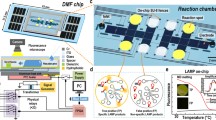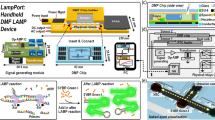Abstract
Quality control requirements imposed on assays used in clinical diagnostics and point-of-care-diagnostic testing (POCT), utilizing amplification reactions performed at elevated temperatures of 35 to 95 °C are very stringent. As the temperature of a reaction vessel has a large impact on the specificity and sensitivity of the amplification reaction, simple tools for local in situ temperature sensing and monitoring are required for reaction and assay control. We describe here a platform of stem-and-loop structured DNA hairpins (molecular beacons, MBs), absorbing and emitting in the visible and red spectral region, rationally designed for precise temperature measurements in microfluidic assays for POCT, and their application for temperature measurements in a common DNA-based molecular biological assay utilizing thermophilic helicase-dependent amplification (tHDA). Spectroscopic studies of these MBs, rationally designed from DNA sequences of different thermal stabilities, chosen not to interact with the DNA probes applied in the nucleic acid amplification assay, and temperature-dependent fluorescence measurements of MB-assay mixtures revealed the suitability of these MBs for temperature measurements directly in such an assay with a temperature resolution of about 0.5 °C without interferences from assay components. Combining two spectrally distinguishable MBs provides a broader response range and an increase in temperature sensitivity up to 0.1 °C. This approach will find future application for temperature monitoring and quality control in commercialized diagnostics assays using dried reagents and microfluidic chips as well as assays read out with tube and microplate readers and PCR detection systems for temperature measurements in the range of 35 to 95 °C.

Molecular beacon platform for optical temperature measurements and quality control in diagnostic assays




Similar content being viewed by others
References
Jaque D, Vetrone F. Luminescence nanothermometry. Nanoscale. 2012;4(15):4301–26. doi:10.1039/c2nr30764b.
Chin CD, Linder V, Sia SK. Commercialization of microfluidic point-of-care diagnostic devices. Lab Chip. 2012;12(12):2118–34. doi:10.1039/c2lc21204h.
(CLSI). CaLSI. Quantitative molecular methods for infectious diseases; approved guideline—second edition. CLSI document MM06-A2 (ISBN 1-56238-736-7) 2010;30(22).
Iwamoto T, Sonobe T, Hayashi K. Loop-mediated isothermal amplification for direct detection of Mycobacterium tuberculosis complex, M-avium, and M-intracellulare in sputum samples. J Clin Microbiol. 2003;41(6):2616–22. doi:10.1128/jcm.41.6.2616-2622.2003.
Vincent M, Xu Y, Kong HM. Helicase-dependent isothermal DNA amplification. EMBO Rep. 2004;5(8):795–800. doi:10.1038/sj.embor.7400200.
Jeong YJ, Park K, Kim DE. Isothermal DNA amplification in vitro: the helicase-dependent amplification system. Cell Mol Life Sci. 2009;66(20):3325–36. doi:10.1007/s00018-009-0094-3.
Mahony JB, Petrich A, Smieja M. Molecular diagnosis of respiratory virus infections. Crit Rev Clin Lab Sci. 2011;48(5–6):217–49. doi:10.3109/10408363.2011.640976.
Scheler O, Glynn B, Kurg A. Nucleic acid detection technologies and marker molecules in bacterial diagnostics. Expert Rev Mol Diagn. 2014;14(4):489–500. doi:10.1586/14737159.2014.908710.
Lahiri BB, Bagavathiappan S, Jayakumar T, Philip J. Medical applications of infrared thermography: a review. Infrared Phys Technol. 2012;55(4):221–35. doi:10.1016/j.infrared.2012.03.007.
Schäferling M. The art of fluorescence imaging with chemical sensors. Angew Chem Int Ed. 2012;51:2–25. doi:10.1002/anie.201105459.
Lou JF, Finegan TM, Mohsen P, Hatton TA, Laibinis PE. Fluorescence-based thermometry: principles and applications. Rev Anal Chem. 1999;18(4):235–84.
Ross D, Gaitan M, Locascio LE. Temperature measurements in microfluidic systems using a temperature-dependent fluorescent dye. Anal Chem. 2001;73(17):4117–23.
Ross D, Locascio LE. Fluorescence thermometry in microfluidics. CP684, temperature: its measurement and control in science and industry. American Institute of Physics; 2003.
Estrada-Perez CE, Hassan YA, Tan S. Experimental characterization of temperature sensitive dyes for laser induced fluorescence thermometry. Rev Sci Instrum. 2011;82(7):074901–7.
Freddi S, Sironi L, D’Antuono R, Morone D, Dona A, Cabrini E, et al. A molecular thermometer for nanoparticles for optical hyperthermia. Nano Lett. 2013;13(5):2004–10. doi:10.1021/nl400129v.
Homma M, Takei Y, Murata A, Inoue T, Takeoka S. A ratiometric fluorescent molecular probe for visualization of mitochondrial temperature in living cells. Chem Commun. 2015;51(28):6194–7. doi:10.1039/c4cc10349a.
Arai S, Suzuki M, Park SJ, Yoo JS, Wang L, Kang NY, et al. Mitochondria-targeted fluorescent thermometer monitors intracellular temperature gradient. Chem Commun. 2015;51(38):8044–7. doi:10.1039/c5cc01088h.
Nurmi J, Wikman T, Karp M, Lovgren T. High-performance real-time quantitative RT-PCR using lanthanide probes and a dual-temperature hybridization assay. Anal Chem. 2002;74(14):3525–32. doi:10.1021/ac020093y.
Brites CDS, Lima PP, Silva NJO, Millan A, Amaral VS, Palacio F, et al. Lanthanide-based luminescent molecular thermometers. New J Chem. 2011;35(6):1177–83. doi:10.1039/c0nj01010c.
Borisov SM, Mayr T, Klimant I. Poly(styrene-block-vinylpyrrolidone) beads as a versatile material for simple fabrication of optical nanosensors. Anal Chem. 2008;80(3):573–82. doi:10.1021/ac071374.
Takei Y, Arai S, Murata A, Takabayashi M, Oyama K, Ishiwata S, et al. A nanoparticle-based ratiometric and self-calibrated fluorescent thermometer for single living cells. ACS Nano. 2014;8(1):198–206. doi:10.1021/nn405456e.
Natrajan VK, Christensen KT. Two-color laser-induced fluorescent thermometry for microfluidic systems. Meas Sci Technol. 2009;20(1). doi:10.1088/0957-0233/20/1/015401.
Soleilhac A, Dagany X, Dugourd P, Girod M, Antoine R. Correlating droplet size with temperature changes in electrospray source by optical methods. Anal Chem. 2015;87(16):8210–7. doi:10.1021/acs.analchem.5600976.
Uchiyama S, Tsuji T, Ikado K, Yoshida A, Kawamoto K, Hayashi T, et al. A cationic fluorescent polymeric thermometer for the ratiometric sensing of intracellular temperature. Analyst. 2015;140(13):4498–506. doi:10.1039/c5an00420a.
Hu XL, Li Y, Liu T, Zhang GY, Liu SY. Intracellular cascade FRET for temperature imaging of living cells with polymeric ratiometric fluorescent thermometers. ACS Appl Mater Interfaces. 2015;7(28):15551–60. doi:10.1021/acsami.5b04025.
Gota C, Okabe K, Funatsu T, Harada Y, Uchiyama S. Hydrophilic fluorescent nanogel thermometer for intracellular thermometry. J Am Chem Soc. 2009;131(8):2766−+. doi:10.1021/ja807714j.
Liu J, Guo XD, Hu R, Xu J, Wang SQ, Li SY, et al. Intracellular fluorescent temperature probe based on triarylboron substituted poly N-isopropylacrylamide and energy transfer. Anal Chem. 2015;87(7):3694–8. doi:10.1021/acs.analchem.5b00887.
Shang L, Stockmar F, Azadfar N, Nienhaus GU. Intracellular thermometry by using fluorescent gold nanoclusters. Angew Chem Int Ed. 2013;52(42):11154–7. doi:10.1002/anie.201306366.
Sedlmeier A, Achatz DE, Fischer LH, Gorris HH, Wolfbeis OS. Photon upconverting nanoparticles for luminescent sensing of temperature. Nanoscale. 2012;4(22):7090–6. doi:10.1039/c2nr32314a.
Fischer LH, Harms GS, Wolfbeis OS. Upconverting nanoparticles for nanoscale thermometry. Angew Chem Int Ed. 2011;50(20):4546–51. doi:10.1002/anie.201006835.
Chen R, Ta VD, Xiao F, Zhang QY, Sun HD. Multicolor hybrid upconversion nanoparticles and their improved performance as luminescence temperature sensors due to energy transfer. Small. 2013;9(7):1052–7. doi:10.1002/smll.201202287.
Okabe K, Inada N, Gota C, Harada Y, Funatsu T, Uchiyama S. Intracellular temperature mapping with a fluorescent polymeric thermometer and fluorescence lifetime imaging microscopy. Nat Commun. 2012; 3. doi:10.1038/ncomms1714.
Tyagi S, Kramer FR. Molecular beacon probes that fluorescence upon hybridization. Nat Biotechnol. 1996;14(3):303–8.
Raphael MP, Christodoulides JA, Qadri SN, Qadri SA, Miller MM, Kurihara LK, et al. The use of DNA molecular beacons as nanoscale temperature probes for microchip-based biosensors. Biosens Bioelectron. 2008;24(4):888–92. doi:10.1016/j.bios.2008.07.028.
Ebrahimi S, Akhlaghi Y, Kompany-Zareh M, Rinnan A. Nucleic acid based fluorescent nanothermometers. ACS Nano. 2014;8(10):10372–82. doi:10.1021/nn5036944.
Ke GL, Wang CM, Ge Y, Zheng NF, Zhu Z, Yang CJ. L-DNA molecular beacon: a safe, stable, and accurate intracellular nano-thermometer for temperature sensing in living cells. J Am Chem Soc. 2012;134(46):18908–11. doi:10.1021/ja3082439.
Barilero T, Le Saux T, Gosse C, Jullien L. Fluorescent thermometers for dual-emission-wavelength measurements: molecular engineering and application to thermal imaging in a microsystem. Anal Chem. 2009;81(19):7988–8000. doi:10.1021/ac901027f.
Nellaker C, Wallgren U, Karlsson H. Molecular beacon-based temperature control and automated analyses for improved resolution of melting temperature analysis using SYBR I Green chemistry. Clin Chem. 2007;53(1):98–103. doi:10.1373/clinchem.2006.075184.
Tyagi S, Marras SAE, Kramer FR. Wavelength-shifting molecular beacons. Nat Biotechnol. 2000;18(11):1191–6.
Stellacci FCAB, Meyer-Friedrichsen T, Wenseleers W, Marder SR, Perry JW. Ultrabright supramolecular beacons based on the self-assembly of two-photon chromophores on metal nanoparticles. J Am Chem Soc. 2003;125(2):328–9.
Roh SS, Smith LE, Lee JS, Via LE, Barry CE, Alland D et al. Comparative evaluation of sloppy molecular beacon and dual-labeled probe melting temperature assays to identify mutations in mycobacterium tuberculosis resulting in rifampin, fluoroquinolone and aminoglycoside resistance. Plos One. 2015;10(5). doi:10.1371/journal.pone.0126257.
Fair RB, Khlystov A, Tailor TD, Ivanov V, Evans RD, Griffin PB, et al. Chemical and biological applications of digital-microfluidic devices. IEEE Des Test Comput. 2007;24(1):10–24. doi:10.1109/mdt.2007.8.
Würth C, Grabolle M, Pauli J, Spieles M, Resch-Genger U. Relative and absolute determination of fluorescence quantum yields of transparent samples. Nat Protoc. 2013;8(8):1535–50. doi:10.1038/nprot.2013.087.
Wurth C, Lochmann C, Spieles M, Pauli J, Hoffmann K, Schuttrigkeit T, et al. Evaluation of a commercial integrating sphere setup for the determination of absolute photoluminescence quantum yields of dilute dye solutions. Appl Spectrosc. 2010;64(7):733–41.
Markham NR, Zuker M. DINAMelt web server for nucleic acid melting prediction. Nucleic Acids Res. 2005;33:W577–81. doi:10.1093/nar/gki591.
Resch-Genger U, DeRose PC. Characterization of photoluminescence measuring systems (IUPAC Technical Report). Pure Appl Chem. 2012;84(8):1815–35.
Lakowicz JR. Principles of fluorescence spectroscopy. 3rd ed. Principles of fluorescence spectroscopy. New York: Springer Science + Business Media, LLC; 2006.
Moreira BG, You Y, Behlke MA, Owczarzy R. Effects of fluorescent dyes, quenchers, and dangling ends on DNA duplex stability. Biochem Biophys Res Commun. 2005;327(2):473–84. doi:10.1016/j.bbrc.2004.12.035.
Kubin RF, Fletcher AN. Fluorescence quantum yields of some rhodamine dyes. J Lumin. 1982;27:455–62.
Mao DQ, Liu XG, Qiao QL, Yin WT, Zhao M, Cole JM, et al. Coumarin 545: an emission reference dye with a record-low temperature coefficient for ratiometric fluorescence based temperature measurements. Analyst. 2015;140(4):1008–13. doi:10.1039/c4an02075h.
Fare TL, Coffey EM, Dai H, He YD, Kessler DA, Kilian KA, et al. Effects of atmospheric ozone on microarray data quality. Anal Chem. 2003;75(17):4672–5.
Piatek AS, Tyagi S, Pol AC, Telenti A, Miller LP, Kramer FR, et al. Molecular beacon sequence analysis for detecting drug resistance in Mycobacterium tuberculosis. Nat Biotechnol. 1998;16(4):359–63. doi:10.1038/nbt0498-359.
Bonnet G, Krichevsky O, Libchaber A. Kinetics of conformational fluctuations in DNA hairpin-loops. Proc Natl Acad Sci U S A. 1998;95(15):8602–6. doi:10.1073/pnas.95.15.8602.
Goddard NL, Bonnet G, Krichevsky O, Libchaber A. Sequence dependent rigidity of single stranded DNA. Phys Rev Lett. 2000;85(11):2400–3. doi:10.1103/PhysRevLett.85.2400.
You Y, Tataurov AV, Owczarzy R. Measuring thermodynamic details of DNA hybridization using fluorescence. Biopolymers. 2011;95(7):472–86. doi:10.1002/bip.21615.
Lutz S, Weber P, Focke M, Faltin B, Hoffmann J, Muller C, et al. Microfluidic lab-on-a-foil for nucleic acid analysis based on isothermal recombinase polymerase amplification (RPA). Lab Chip. 2010;10(7):887–93. doi:10.1039/b921140c.
Hicke B, Pasko C, Groves B, Ager E, Corpuz M, Frech G, et al. Automated detection of toxigenic clostridium difficile in clinical samples: isothermal tcdB amplification coupled to array-based detection. J Clin Microbiol. 2012;50(8):2681–7. doi:10.1128/jcm.00621-12.
Keller M, Naue J, Zengerle R, von Stetten F, Schmidt U. Automated forensic animal family identification by nested PCR and melt curve analysis on an off-the-shelf thermocycler augmented with a centrifugal microfluidic disk segment. Plos One. 2015;10(7). doi:10.1371/journal.pone.0131845.
Czilwik G, Messinger T, Strohmeier O, Wadle S, von Stetten F, Paust N, et al. Rapid and fully automated bacterial pathogen detection on a centrifugal-microfluidic LabDisk using highly sensitive nested PCR with integrated sample preparation. Lab Chip. 2015;15(18):3749–59. doi:10.1039/c5lc00591d.
Stumpf F, Schwemmer F, Hutzenlaub T, Baumann D, Strohmeier O, Dingemanns G, et al. LabDisk with complete reagent prestorage for sample-to-answer nucleic acid based detection of respiratory pathogens verified with influenza A H3N2 virus. Lab Chip. 2016;16(1):199–207. doi:10.1039/c5lc00871a.
Escadafal C, Faye O, Sall AA, Faye O, Weidmann M, Strohmeier O et al. Rapid molecular assays for the detection of yellow fever virus in low-resource settings. PLoS Negl Trop Dis. 2014;8(3). doi:10.1371/journal.pntd.0002730.
Acknowledgments
We gratefully acknowledge the contributions and help from Dr. W. Bremser for the statistical evaluation of the data, from M. Moser for the figures, and from Dr. D. Geissler for the calculation of the FRET efficiencies as well as the financial support from the Federal Ministry of Education and Research (BMBF; grant 16SV5439 from the project [RES]Check).
Author information
Authors and Affiliations
Corresponding author
Ethics declarations
Conflict of interest
The authors declare that they have no conflict of interest.
Electronic supplementary material
Below is the link to the electronic supplementary material.
ESM 1
(PDF 782 kb)
Rights and permissions
About this article
Cite this article
Fidan, Z., Wende, A. & Resch-Genger, U. Visible and red emissive molecular beacons for optical temperature measurements and quality control in diagnostic assays utilizing temperature-dependent amplification reactions. Anal Bioanal Chem 409, 1519–1529 (2017). https://doi.org/10.1007/s00216-016-0088-6
Received:
Revised:
Accepted:
Published:
Issue Date:
DOI: https://doi.org/10.1007/s00216-016-0088-6




